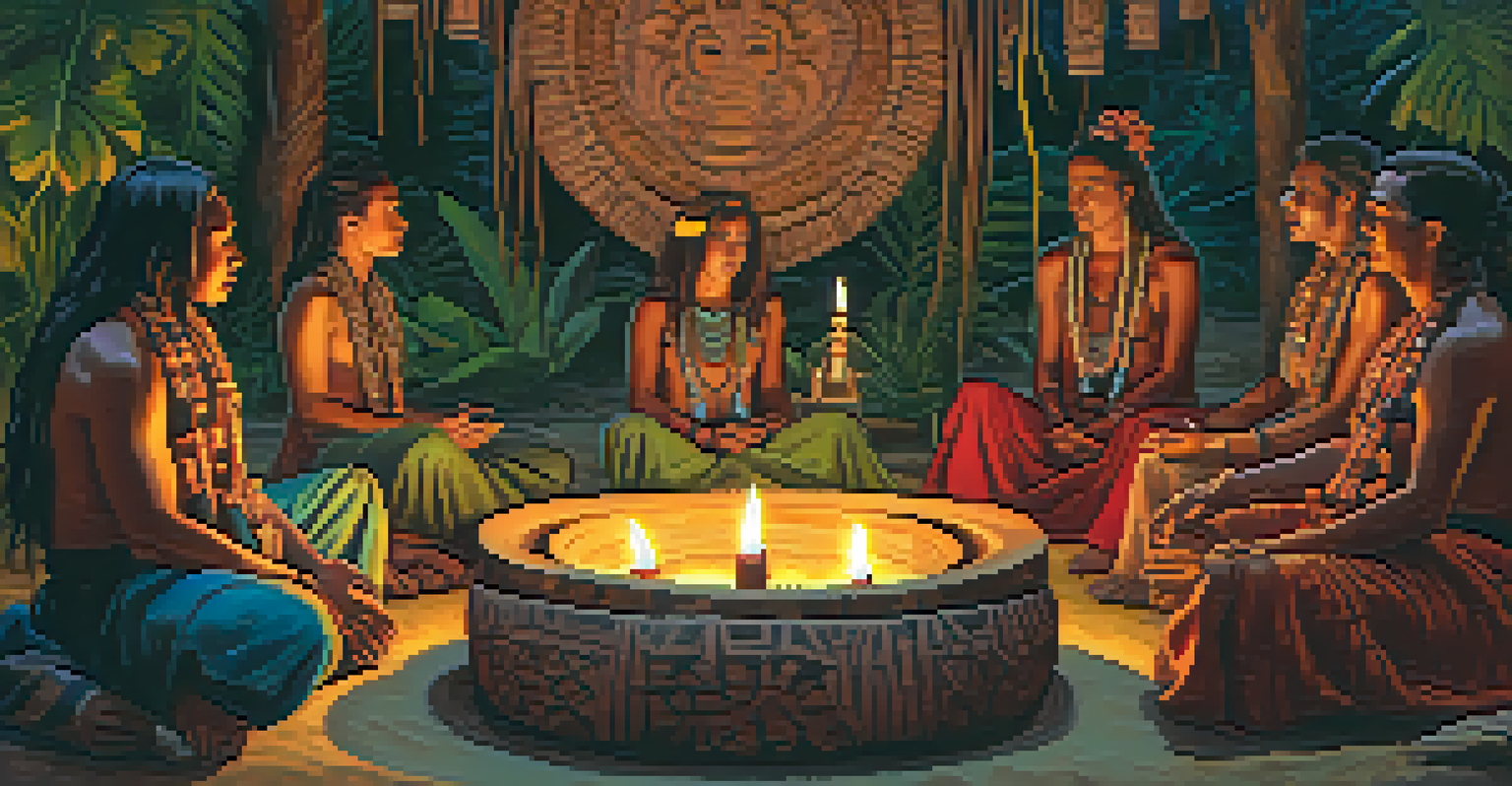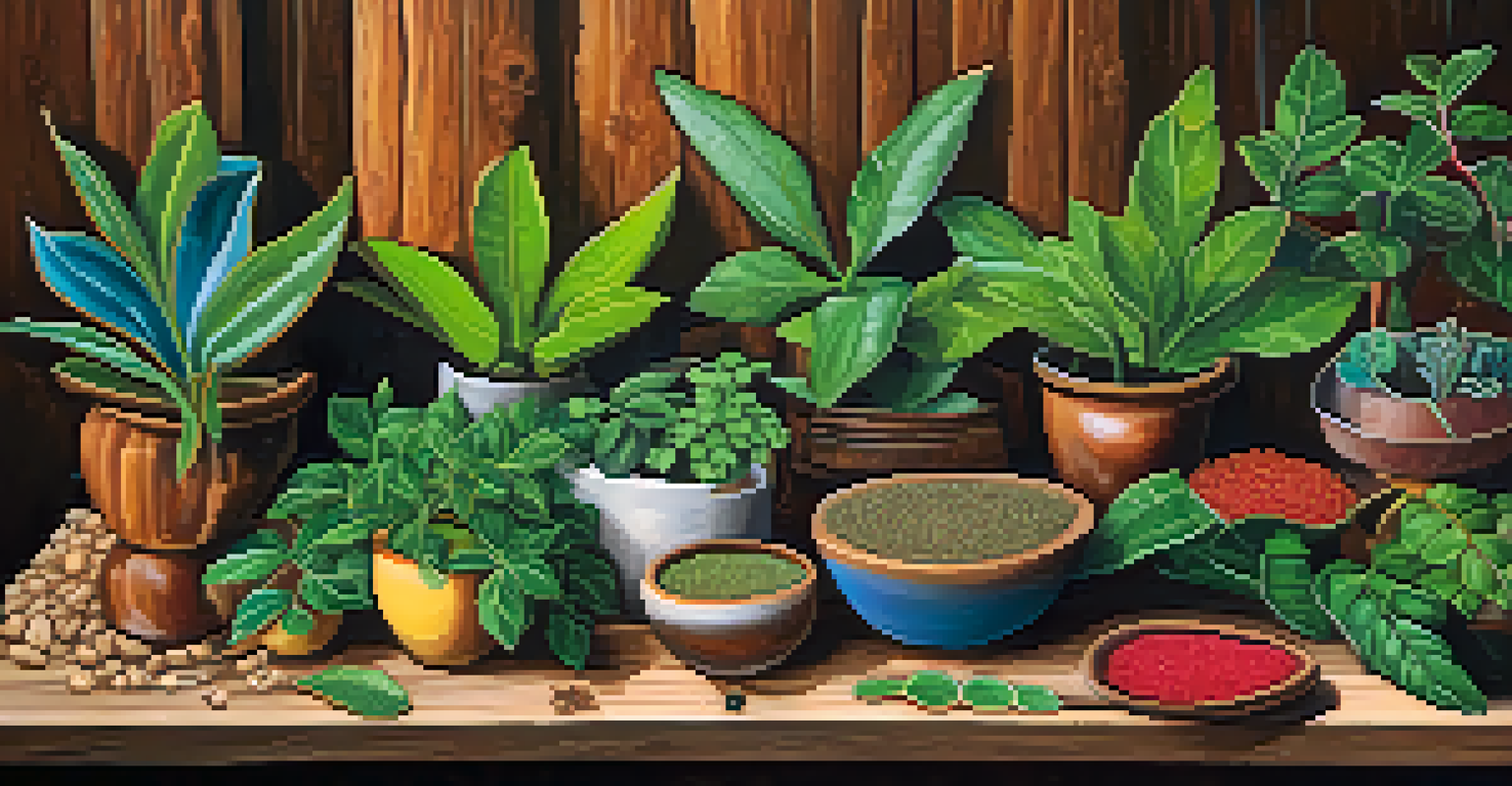Exploring the Healing Properties of Ayahuasca and Its Plants

What is Ayahuasca and Its Cultural Significance?
Ayahuasca is a traditional Amazonian brew made from the Banisteriopsis caapi vine and other plants. Its use dates back thousands of years among indigenous tribes for spiritual and healing purposes. The brew is often consumed during ceremonies led by shamans, who guide participants through transformative experiences.
The plant is the teacher; it shows you what you need to see.
The cultural significance of Ayahuasca extends beyond just its psychoactive effects; it represents a deep connection with nature and the spiritual realm. Many practitioners report profound insights into their lives, relationships, and personal challenges during these ceremonies. This deep-rooted tradition highlights the importance of community and shared experiences in the healing journey.
As interest in Ayahuasca grows globally, its cultural roots and ethical practices are increasingly being recognized. Respecting the indigenous knowledge and ensuring responsible use of this sacred plant is essential for its preservation and the wellbeing of the communities that have relied on it for generations.
The Healing Properties of Ayahuasca
Ayahuasca is renowned for its potential therapeutic benefits, particularly in treating mental health issues. Many users report significant reductions in symptoms of depression, anxiety, and PTSD following ceremonies. The brew is believed to help individuals confront and process deep-seated emotional pain, leading to healing and personal growth.

The active compounds in Ayahuasca, particularly DMT (dimethyltryptamine) and harmala alkaloids, work together to create a unique experience. DMT is a powerful hallucinogen that can induce vivid visions and insights, while harmala alkaloids act as MAO inhibitors, allowing for a prolonged experience. This combination is thought to facilitate introspection and emotional release.
Ayahuasca's Cultural Roots
Ayahuasca is a traditional Amazonian brew with deep cultural significance, used for spiritual healing in indigenous ceremonies.
Research is still ongoing, but preliminary studies suggest that Ayahuasca may promote neurogenesis, or the growth of new brain cells. This could further enhance its therapeutic effects, making it a fascinating area of study for mental health professionals and researchers alike.
The Role of the Shaman in Ayahuasca Ceremonies
Shamans, or ayahuasqueros, play a crucial role in guiding participants through their Ayahuasca experiences. They are often seen as healers and spiritual leaders, using their knowledge of the plants and ceremonies to facilitate healing. Their presence provides a sense of safety and support, which is essential during intense emotional and spiritual journeys.
Ayahuasca is a powerful tool for self-exploration, but it requires guidance and respect for its traditions.
During the ceremony, shamans often sing icaros, traditional songs that are believed to help navigate the experience and call upon the spirit of the plants. These songs can evoke powerful emotions and memories, enhancing the healing process. The shaman's guidance is vital in helping participants integrate their experiences afterward.
The relationship between the shaman and the participants is built on trust and respect. As the experience can be deeply personal and sometimes challenging, having an experienced guide can make all the difference in navigating the emotional landscape that arises.
The Plant Allies of Ayahuasca
Ayahuasca is not just a single plant; it’s a brew made from a combination of various plants, each contributing to its healing properties. The primary ingredient, the Banisteriopsis caapi vine, contains harmala alkaloids that enhance the effects of DMT found in other plants, such as Psychotria viridis. This synergy is what makes Ayahuasca such a powerful tool for healing.
In addition to these main plants, various other botanical allies may be used in Ayahuasca brews, depending on the shaman’s tradition and the desired effects. For example, some shamans might incorporate plants like chacruna or datura to deepen the experience or target specific issues. Each plant carries its own unique properties and energies that contribute to the overall journey.
Therapeutic Benefits of Ayahuasca
Many users report significant improvements in mental health issues such as depression and PTSD after participating in Ayahuasca ceremonies.
Understanding these plants and their roles can deepen one’s appreciation for the Ayahuasca experience. Just as a chef combines different ingredients to create a delicious dish, shamans blend these plants to craft a unique healing journey tailored to the needs of the participants.
Integration: The Key to Lasting Healing
Integration refers to the process of making sense of the experiences and insights gained during an Ayahuasca ceremony. It’s essential for translating the often intense and profound revelations into everyday life. Without proper integration, the potential benefits of the experience may fade away, leaving participants feeling lost or confused.
Many people find that working with therapists or support groups after their Ayahuasca experiences can be incredibly helpful. These professionals can provide guidance and tools to help individuals incorporate their insights into daily routines, relationships, and personal growth. This process can empower participants to make meaningful changes in their lives.
Journaling, meditation, and sharing experiences with others are also valuable integration practices. By reflecting on the journey and fostering connections with like-minded individuals, participants can solidify their healing and continue to grow long after the ceremony has ended.
Potential Risks and Considerations
While Ayahuasca has many potential healing benefits, it’s important to acknowledge the risks involved. The brew can provoke intense emotional responses and unexpected psychological effects, which may be overwhelming for some individuals. Therefore, it’s crucial for participants to approach Ayahuasca with caution and respect.
Pre-existing mental health conditions, particularly schizophrenia or bipolar disorder, can be exacerbated by Ayahuasca. It’s essential for individuals to consult with healthcare professionals before participating in ceremonies, ensuring they’re well-informed about the potential risks. Creating a safe space for open dialogue about one’s mental health history is vital.
Importance of Integration
Integration is crucial for translating the profound insights gained during Ayahuasca experiences into everyday life for lasting healing.
Choosing a reputable shaman and ceremony space is equally important. Participants should seek out experienced facilitators who prioritize safety and ethical practices. This ensures that the healing journey is conducted within a supportive and respectful environment, maximizing the benefits while minimizing risks.
The Future of Ayahuasca and Its Healing Potential
As interest in Ayahuasca continues to grow worldwide, the conversation around its therapeutic potential is becoming increasingly prominent. Researchers, mental health professionals, and spiritual seekers alike are exploring how this ancient practice can be integrated into modern healing modalities. This could lead to new approaches to mental health treatment and personal development.
With more scientific studies underway, we can expect to see a deeper understanding of the mechanisms behind Ayahuasca’s effects. This research may help legitimize its use in various therapeutic contexts and inform best practices for both practitioners and participants. The more we learn, the better we can harness its potential for healing.

Ultimately, the future of Ayahuasca lies in balancing respect for its traditional roots with the evolving landscape of modern therapy. As we navigate this journey, it’s crucial to honor the cultures from which Ayahuasca originates while embracing its potential to facilitate healing for those who seek it.